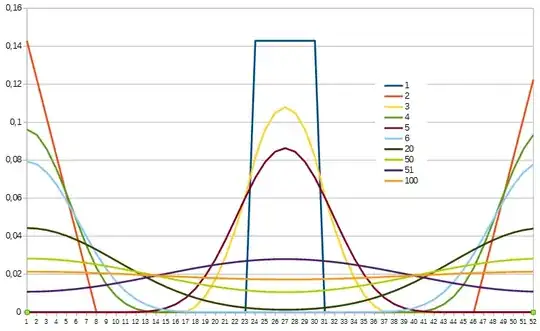The following problem I can only seem to solve by simulation.
Suppose we take a deck and just label the cards from 1-52 in order, with 1 being the card on top. Now suppose we cut the deck at approximately the middle and complete the cut.
We could assume that there's an equal probability that we cut at each of 3 cards near the exact middle; that is, we either cut at exactly the middle (26 cards in hand), or we cut up to 29 cards or as few as 23 cards, all with equal probability.
Then we could ask, what's the probability that the $n$th card is now on top? The answer is simply $0$ for most of the cards, and $\frac{1}{7}$ that cards 24, 25, 26, 27, 28, 29, or 30 are on top.
But suppose we perform this cut twice, what then? I think the simplest answer unfortunately is just to sum up all the ways you can make each outcome and total the probability. For example, obviously card #1 is most likely to return back on top after cutting twice. This can happen if you cut exactly in the middle twice, if you're short one and then long one, if you're short two and then long two, etc. In total, there is a $\frac{7}{49}$ chance card 1 is on top, a $\frac{6}{49}$ chance that card 2 is on top, etc.
I'm having trouble finding a general pattern here. If you have an odd number of cuts, the most likely cards are somewhere near the middle of the range 1-52; an even number of cuts and the most likely cards are near the edges. But how do I describe this mathematically?
